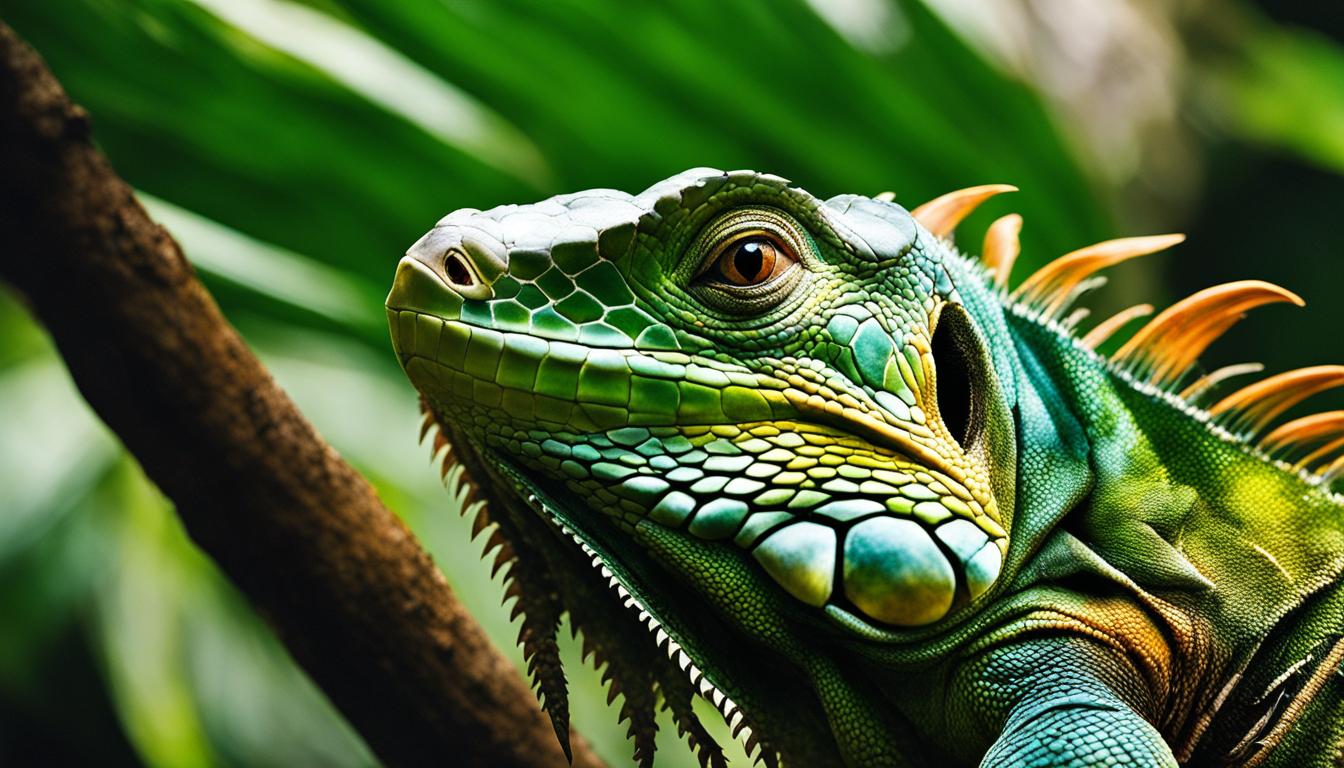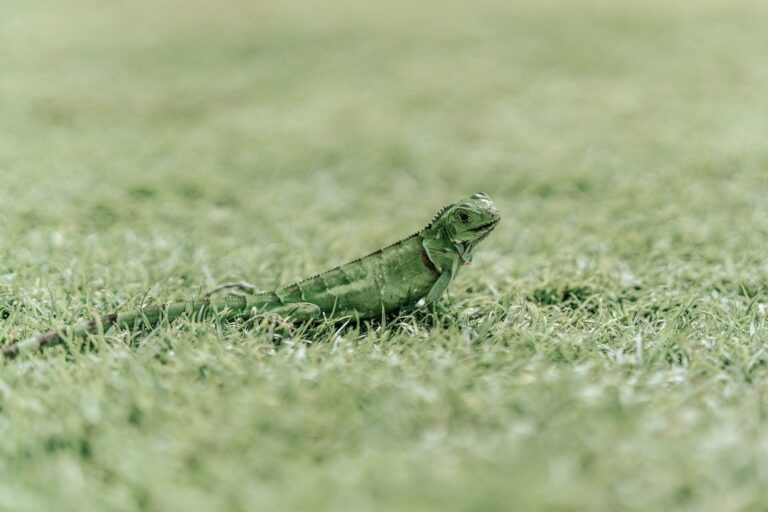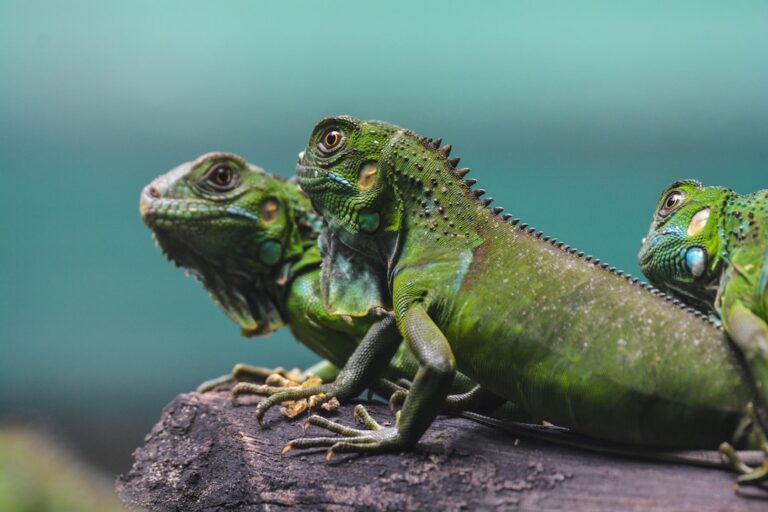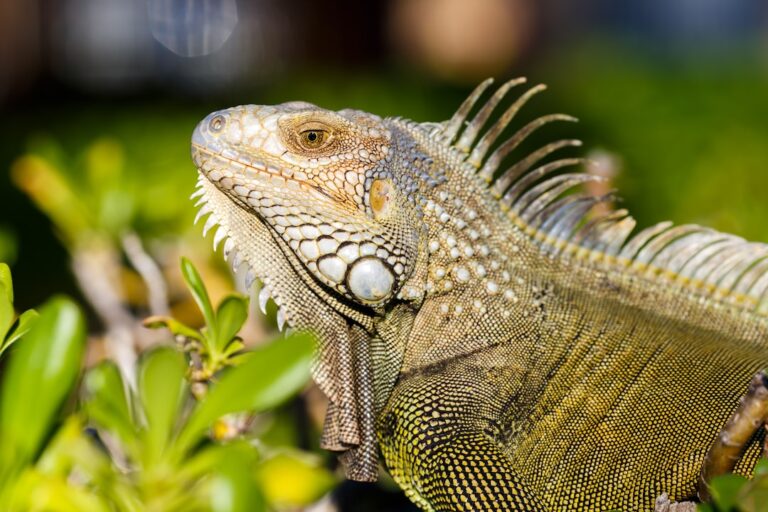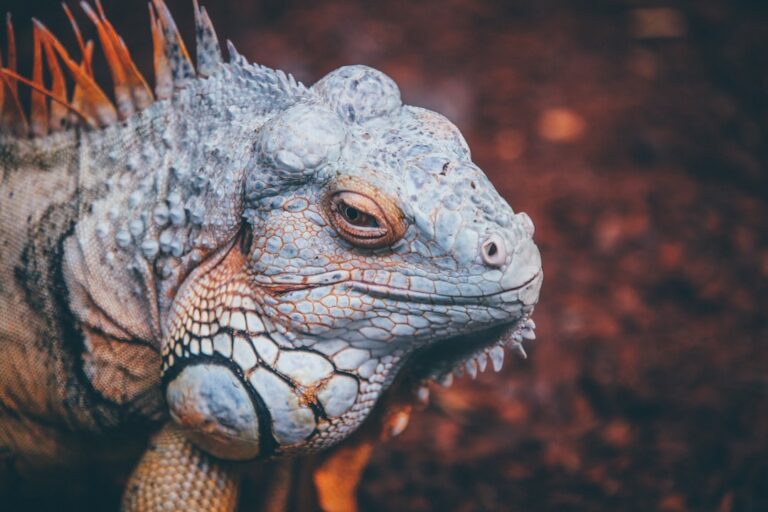Do Iguanas Blink?
Have you ever wondered if iguanas blink? These fascinating reptiles have captured the curiosity of many animal lovers. In this article, we will explore the intriguing world of iguana’s vision, reptile eye movements, and their sleep behavior. So, let’s dive into the world of iguanas!
Table of Contents
Key Takeaways:
- Iguanas do blink, but not very often compared to other animals.
- They have three eyes, but only two of them blink.
- Blinking helps iguanas clean their eyes from irritants and alleviate discomfort from eye injuries.
- In the wild, they may blink less frequently to stay alert.
- In captivity, iguanas may blink more often due to a safe environment and increased comfort.
Unveiling the Mystery of Iguana’s Vision
When it comes to the fascinating world of iguanas, one aspect that often captures the attention of enthusiasts and researchers is their unique vision. Understanding how these reptiles see the world around them involves delving into the significance of blinking in reptiles and exploring the remarkable structure of their eyes.
The Significance of Blinking in Reptiles
Blinking is an essential behavior in the animal kingdom, helping to protect and cleanse the eyes by removing irritants and moisturizing the surface. In reptiles, including iguanas, blinking serves a critical role in maintaining eye health. By regularly blinking, iguanas keep their eyes moist and comfortable, preventing dryness and reducing the risk of infection.
Iguanas have an intriguing eye structure, with three eyes in total. While the third eye, known as the parietal eye, doesn’t possess the ability to blink, the other two eyes perform the typical blinking function. These blinking movements are vital to keep the eyes lubricated and free from debris, allowing the iguana to navigate its environment effectively.
Iguanas’ Unique Eye Structure
One of the most remarkable features of iguanas is their distinct eye structure. Their eyes, with a spherical shape similar to other reptiles, possess a horizontally elongated pupil that can expand and contract to regulate the entry of light. This unique pupil shape enhances their visual capabilities, allowing them to adapt to different lighting conditions effectively.
Furthermore, iguanas have vivid color vision, enabling them to perceive their surroundings with exceptional clarity. This enhanced color vision not only aids in identifying potential threats or food sources but also contributes to their social interactions and mating behavior.
Through their remarkable eye structure and blinking behavior, iguanas demonstrate a fascinating adaptation that supports their survival in diverse environments. Further exploration of the intricacies of their vision capabilities can uncover even more insights into the world of these magnificent reptiles.
A Closer Look at the Iguana’s Three Eyes
Iguanas, known for their unique eye structure, have three eyes. While the first two eyes are positioned on the sides of their head, the third eye is located on top, giving them a distinct appearance. This intriguing feature raises questions about the function and capabilities of the iguana’s three eyes.
The Function of the Third Eye in Survival
The third eye of an iguana serves a vital role in its survival. Positioned on top of their head, this eye has a unique ability to sense changes in movement and detect potential predators. By constantly monitoring their surroundings from different angles, iguanas gain a heightened awareness of their environment, enabling them to stay alert and respond swiftly to threats.
How the Third Eye Compensates for Limited Night Vision
Although iguanas possess impressive vision, their ability to see clearly in low light conditions, such as during the night, is limited. This is where the third eye becomes particularly valuable. While the iguana’s main eyes rely on visible light, the third eye is responsive to changes in brightness, allowing them to compensate for their reduced night vision. By using their third eye in conjunction with their main eyes, iguanas can navigate and function effectively during darker periods.
The remarkable adaptations of the iguana’s three eyes contribute to their survival and enhance their ability to thrive in diverse environments. Understanding the functions of each eye sheds light on their visual capabilities and underscores the fascinating nature of these reptiles.
Do Iguanas Blink
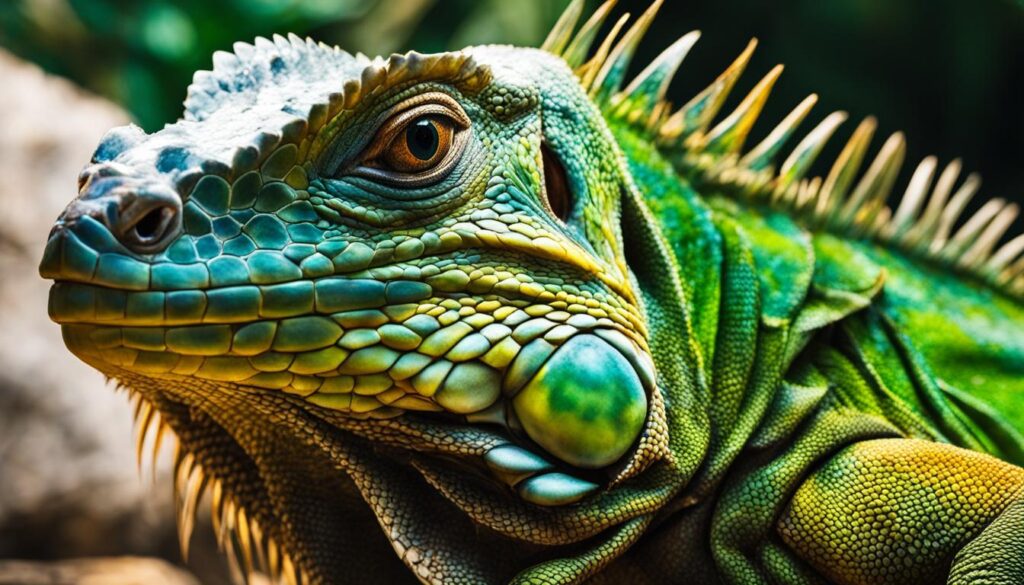
Yes, iguanas do blink, but not as frequently as humans or many other animals. Their blinking behavior is essential for maintaining eye health and cleanliness. Despite their unique eye structure and adaptations, they don’t need to blink as often as other species.
Iguanas have three eyes, but only two of them blink. The third eye, located on top of their head, doesn’t blink at all. This unique eye structure allows iguanas to adapt to their surroundings and survive with less frequent blinking.
Blinking is important for iguanas to clean their eyes from irritants and to alleviate discomfort from eye injuries. While blinking is a natural process for many animals, iguanas have developed mechanisms to minimize the need for frequent blinking.
In the wild, where iguanas are preyed upon, they blink less frequently to stay alert and vigilant. This adaptation helps them remain cautious of potential predators. However, in captivity, where they are protected and have a safe environment, iguanas may blink more often due to increased comfort and reduced threat perception.
Overall, iguanas’ reduced need for frequent blinking is an interesting aspect of their behavior and physiology. It showcases their ability to adapt to different environments and survival strategies. Understanding the unique eye structure and blinking patterns of iguanas provides valuable insights into their biology and adaptation mechanisms.
The Significance of Blinking for Iguanas
Blinking serves several significant purposes for iguanas. It helps remove irritants such as dirt and foreign objects that may enter their eyes. Blinking also plays a role in responding to eye injuries, as the constant blinking provides relief from discomfort. The frequency of blinking can indicate the presence of eye issues or injuries and should be monitored for abnormal patterns.
Blinking to Remove Irritants
Iguanas rely on blinking to remove irritants that may come into contact with their eyes. Dust, dirt, or other foreign particles can cause discomfort and potential damage to the eyes if not removed promptly. Blinking helps to sweep away these irritants and keep the eyes clean and healthy.
Regular blinking maintains the moisture levels in their eyes and prevents dryness, which can lead to further irritation. By consistently blinking, iguanas effectively flush out any irritants and maintain optimal eye health.
The Role of Blinking in Injury Response
Blinking is also an instinctive response of iguanas to relieve discomfort caused by eye injuries. In the event of an injury, the constant blinking helps to alleviate pain and promote healing. The repeated blinking motion can create a soothing effect, providing temporary relief from any discomfort or inflammation.
Additionally, the frequency of blinking can serve as an indicator of possible eye injuries in iguanas. If an iguana exhibits excessive or abnormal blinking patterns, it may suggest the presence of an underlying eye issue that requires attention from a veterinarian.
| Benefits of Blinking for Iguanas | |
|---|---|
| Removes irritants | Relieves discomfort |
| Maintains eye health | Indicates possible eye injuries |
Comparing Iguana Blinking in the Wild vs. Captivity
In the wild, iguanas face the constant threat of predation from snakes and birds. In order to increase their chances of survival, wild iguanas have adapted their blinking patterns to ensure they stay alert and vigilant. They blink less frequently, allowing them to remain vigilant and spot potential dangers more easily.
However, in captivity, where safety is guaranteed and predators are absent, iguanas exhibit more relaxed blinking patterns. In these controlled environments, they feel secure and don’t need to be as constantly alert. As a result, their blinking patterns become more relaxed and occur at a higher frequency.
To illustrate the contrast between wild and captive iguanas’ blinking patterns, refer to the table below:
| Blinking Patterns | Wild Iguanas | Captive Iguanas |
|---|---|---|
| Blink Frequency | Less frequent | More frequent |
| Alertness Level | High | Relaxed |
This image captures the essence of an iguana blinking in the wild, showcasing their adaptability and resilience in the face of predation.
Understanding these adaptations in blinking patterns provides valuable insights into the behavior and survival strategies of iguanas.
Recognizing Abnormal Blinking in Iguanas
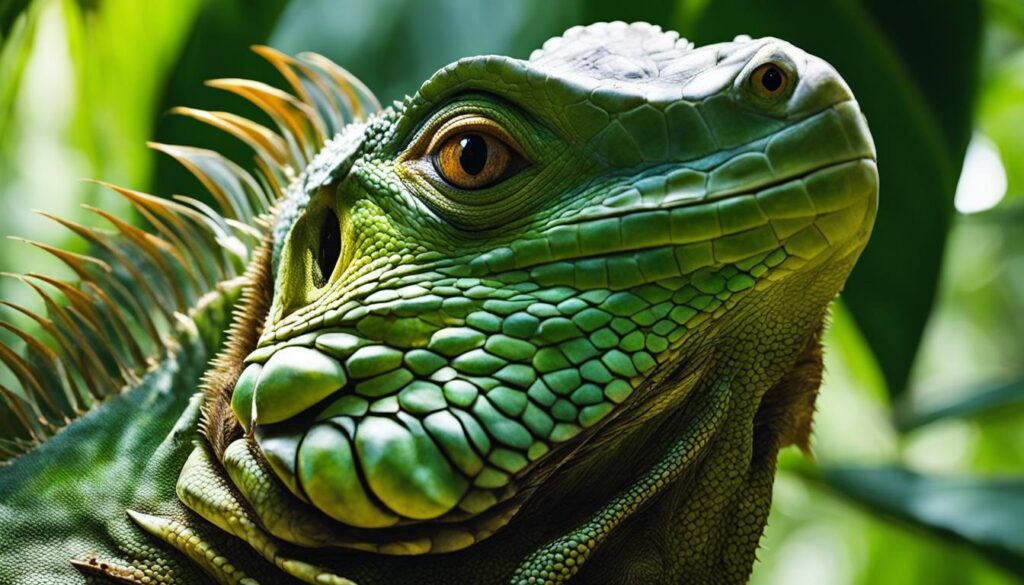
Abnormal blinking in iguanas can be a potential indicator of underlying health issues. While iguanas do blink, frequent and excessive blinking may signify eye irritation, infection, or injury. It is important for iguana owners to pay close attention to their pet’s blinking patterns and behavior to ensure their well-being.
When observing your iguana, look out for the following signs of abnormal blinking:
- Rapid or repetitive blinking
- Involuntary or spasmodic blinking
- Excessive tearing or discharge from the eyes
- Redness or swelling around the eyes
If you notice any of these abnormal blinking patterns, it is recommended to seek veterinary care for your iguana.
It’s important to remember that iguanas are adept at hiding signs of illness, so any changes in their normal behavior or blinking should be taken seriously. Early detection and prompt medical attention can help prevent further complications and ensure the overall health and well-being of your iguana.
| Cause | Description |
|---|---|
| Eye irritation | Foreign objects, dust, or particles that irritate the eyes |
| Eye infection | Bacterial or viral infections affecting the eyes |
| Eye injury | Scratches, cuts, or trauma to the eyes |
| Conjunctivitis | Inflammation of the conjunctiva, the clear membrane covering the white part of the eyes |
| Corneal ulcer | An open sore on the cornea, usually caused by a scratch or injury |
Table: Common Causes of Abnormal Blinking in Iguanas
Identifying the specific cause of abnormal blinking in your iguana may require a thorough examination and diagnostic tests by a veterinarian specializing in reptile care. Veterinary care is crucial in diagnosing and treating the underlying condition, providing your iguana with the necessary care and treatment to alleviate discomfort and promote recovery.
Proper Techniques to Clean an Iguana’s Eyes
Cleaning an iguana’s eyes requires proper techniques and care to prevent further irritation or injury. It is essential to choose the right solutions and practice gentle handling to ensure the health and well-being of your iguana.
Choosing the Right Solutions for Eye Cleaning
When cleaning an iguana’s eyes, it is crucial to use the appropriate solutions. Saline solution or antimicrobial reptile eyewash are commonly recommended options. These solutions are gentle and designed specifically for reptiles, ensuring effective eye cleaning without causing any harm or discomfort to your iguana.
Iguanas have sensitive eyes, and using harsh chemicals or incorrect solutions can lead to irritation or damage. It is best to consult with a reptile veterinarian or an experienced reptile owner to determine the most suitable and safe solution for your iguana.
The Importance of Gentle Handling
Gentle handling is paramount when cleaning an iguana’s eyes. The process should be approached with care and patience to avoid stressing your iguana or causing any discomfort or distress.
Start by creating a calm and quiet environment for the eye cleaning session. It is helpful to have a trusted friend or family member assist you in holding or restraining the iguana gently. This helps ensure the iguana feels secure and prevents any sudden movements that could risk injury during the cleaning process.
Use slow and gentle motions when cleaning the eyes. It is important not to apply excessive pressure or force, as this can cause discomfort or damage to the delicate eye tissues. A soft cotton ball or a clean, lint-free cloth soaked in the chosen eye-cleaning solution can be used to wipe around the iguana’s eyes gently.
Be observant of your iguana’s behavior and cues during the cleaning process. If your iguana appears stressed or agitated, give them a short break before continuing. If the iguana continues to display signs of distress, it is advisable to seek professional help from a reptile veterinarian.
Regular Eye Cleaning for Health and Hygiene
Regular eye cleaning is essential for maintaining the health and hygiene of an iguana’s eyes. By incorporating eye cleaning into your regular pet care routine, you can help prevent eye infections, remove debris, and ensure clear vision for your iguana.
Proper techniques and gentle handling are key when cleaning an iguana’s eyes. By choosing the right solutions, practicing gentle handling, and making eye cleaning a regular part of your iguana’s care, you can ensure the well-being of their eyes and promote a healthy vision.
Understanding Iguana Communication
The Visual Language of Posture and Movement
Iguanas, like many other animals, communicate through their body language. They use various postures and movements to convey messages and express their intentions and emotions. By understanding their visual language, we can gain valuable insights into their behavior and better connect with these fascinating creatures.
Posture and movement play a crucial role in iguana communication. Different postures can indicate their level of comfort, aggression, and submission. For example, an iguana with an upright posture and puffed-out throat is displaying dominance, while a flattened posture and a lowered head may indicate submission or fear.
Observing their movements is also important in interpreting their communication. Aggressive movements, such as tail whipping or head bobbing, may signal a warning to potential threats or rivals. On the other hand, slow and deliberate movements often indicate relaxation and contentment.
Decoding these visual cues allows us to understand and respect an iguana’s boundaries, as well as create a positive and enriching environment for them.
The Tail Tells: Decoding Iguana Tail Movements
The tail of an iguana serves as a significant component of their visual language. It provides important clues about their state of mind and can offer insights into their communication.
When an iguana feels threatened or intimidated, it may raise its tail as a defensive mechanism. A raised tail can signal that the iguana is perceiving a potential danger and is preparing to defend itself. Conversely, a relaxed and loosely hanging tail indicates a sense of security and comfort.
Furthermore, tail wagging is another tail movement commonly observed in iguanas. It can have different meanings depending on the context. In some cases, tail wagging may indicate excitement or anticipation, while in other situations, it may signal stress or agitation. Understanding the specific circumstances and accompanying body language is key to interpreting the true meaning of tail wagging.
Overall, paying close attention to an iguana’s tail movements can provide valuable insights into their emotional state and enhance our ability to communicate and interact with them effectively.
The Behavioral Patterns Linked to Iguana Blinking
Blinking behavior in iguanas is not just a simple eye movement. It is closely linked to their overall behavioral patterns and can provide valuable insights into their well-being and emotional state.
One-eyed Blinking and Its Meanings
One-eyed blinking in iguanas can have different meanings depending on the context. It may indicate the presence of irritants or foreign objects in the eye that need to be cleared. When an iguana blinks with one eye, it is often a natural response to protect and clean the affected eye. However, prolonged or frequent one-eyed blinking can also be a sign of discomfort or stress.
Stress Responses and Eye-Closure in Iguanas
Iguanas can exhibit eye-closure as a stress response. When faced with a threatening or stressful situation, they may partially or fully close their eyes as a coping mechanism. This behavior helps them block out potential threats and reduce sensory input, allowing them to focus on managing the stressor. Eye-closure in iguanas is often accompanied by other stress responses such as increased body tension, color changes, and changes in posture or movement.
Monitoring iguanas’ blinking behavior and any associated changes in their behavior can provide valuable insights into their well-being. If you notice excessive or abnormal blinking, one-eyed blinking, or significant changes in their stress responses, it may be a sign that your iguana is experiencing discomfort or stress. Creating a calm and stress-free environment for your iguana and providing appropriate care can help maintain their well-being.
Conclusion
In conclusion, it is established that iguanas do blink, albeit not as frequently as humans or other animals. Blinking plays a crucial role in maintaining the health and cleanliness of their eyes. It serves to remove irritants and respond to injuries, allowing iguanas to keep their eyes moist and comfortable. The unique eye structure and adaptations of iguanas enable them to survive with less frequent blinking, ensuring their safety in various environments.
Abnormal blinking patterns in iguanas could indicate underlying health issues and should not be overlooked. It is essential for iguana owners to be vigilant and monitor their pet’s blinking behavior. Regular eye cleaning using appropriate techniques is also recommended to prevent discomfort or potential eye infections. By understanding iguana communication and behavioral patterns related to blinking, owners can gain valuable insights into their well-being and emotional state.
To summarize, while iguanas do blink, their blinking behavior differs from that of humans and other animals. Blinking serves important functions for iguanas, such as maintaining eye health, removing irritants, and responding to injuries. By staying aware of abnormal blinking patterns and following proper eye cleaning practices, iguana owners can ensure the well-being of their beloved pets.
FAQ
Do iguanas blink?
Yes, iguanas do blink, but not as frequently as humans or many other animals.
Is blinking important for iguanas?
Blinking is essential for maintaining the health and cleanliness of iguana’s eyes, removing irritants, and responding to injuries.
How many eyes do iguanas have?
Iguanas have three eyes, with the third eye located on top of their head.
What is the function of the third eye in iguanas?
The third eye plays a crucial role in their survival by helping them sense changes in movement and detect potential predators.
Do iguanas blink differently in the wild and in captivity?
Yes, in the wild, iguanas blink less frequently to stay alert and vigilant, while in captivity, they exhibit more relaxed blinking patterns.
What does abnormal blinking in iguanas signify?
Abnormal blinking may indicate underlying health issues such as eye irritation, infection, or injury.
How should I clean my iguana’s eyes?
Cleaning an iguana’s eyes requires choosing the right solutions and practicing gentle handling to prevent further irritation or injury.
How do iguanas communicate?
Iguanas communicate through their body language, using postures, movements, and tail signals to convey messages.
What do iguana’s blinking patterns indicate?
Iguana’s blinking patterns can indicate the presence of irritants or foreign objects in the eye and can be a response to stress or discomfort.

